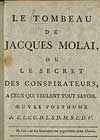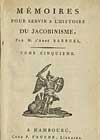Literature
The literature on secret societies is immense and of extremely unequal quality. The dozen titles below are therefore entirely unrepresentative. These are all interesting books based on thorough archival research, which throw light on important aspects of the phenomenon.
- Maurice Agulhon, Pénitents et Franc-Maçons de l'ancienne Provence: essai sur la sociabilité méridionale, Paris: Fayard, 1968 (IISH call number: 32/40)
Demonstrates how the more well-off members of the old religious fraternities switched to the more restricted secular lodges in the eighteenth century; and stimulated academic interest in Freemasonry to such an extent that its bibliography is now hopelessly out-of-date. For an update, see Pierre-Yves Beaurepaire, L'Espace des Franc-Maçons (2003). - Johann Joachim Christoph Bode, Journal von einer Reise von Weimar nach Frankreich im Jahr 1787, ed Hermann Schüttler, Neuried: ars una, 1994 (IISH call number: 2006/661)
The rediscovered diary of a prominent Illuminatus, whose trip to Paris figures in the conspiracy literature as an important step in the launch of the French Revolution. With extensive notes and an introduction by a major specialist. - J.M. Roberts, The Mythology of the Secret Societies, London: Secker & Warburg, 1972 (IISH call number: 74/50)
A now classic study, the first to place the European secret societies of the Restoration in perspective, throwing doubt on both their effectiveness and the danger they posed. - Ferdinand de Bertier, Souvenirs inédits d'un conspirateur: Révolution, Empire et première Restauration, ed Guillaume de Bertier de Sauvigny, Paris: Tallandier, 1990 (IISH call number: 2006/8360)
The memoirs of a royalist conspirator against Napoleon, who joined Freemasonry in order to learn how to build a Catholic secret society, the Chevaliers de la Foi. Edited by a historian of the Restoration who happens to be a descendant of the author. - Vito Dicara, Elite di periferia: conflitti locali e carboneria a Caltagirone tra monarchia amministrativa e guerra independentista, Caltanissetta: Ed Lussografica, 2004 (IISH call number: 2006/8372)
A detailed study of Carbonaro life in the political and social context of a small Sicilian town. - Pierre-Arnaud Lambert, La Charbonnerie française 1821-1823: du secret en politique, Lyon: Presses universitaires de Lyon, 1995 (IISH call number: 1997/2865)
Written by a political scientist, who naturally relied on Alan Spitzer's Old Hatreds and Young Hopes (1971), this book compares the Charbonnerie to other French, German, and Italian secret societies. Unusually, it pays serious attention to such documents as their rules, which tend to be neglected in favour of program documents. - Geoffrey Cubitt, The Jesuit Myth: conspiracy theory and politics in nineteenth-century France, Oxford: Clarendon, 1993 (IISH call number: 1994/811)
Inventory and analysis of the anti-Jesuit conspiracy theories that formed the progressive counterpart to certain conservative views on Freemasonry, and were never absent from the political debate in nineteenth-century France and several other countries. - David MacKenzie, Violent Solutions: revolutions, nationalism, and secret societies in Europe to 1918, Lanham, MD etc: University Press of America, 1996 (IISH call number: 1997/5211)
The greatest authority on the notorious Black Hand puts this Serbian secret society in a European perspective emphasizing, alongside Greek and Russian examples, the parallels from the history of Italian and German unification. - Kevin Kenny, Making Sense of the Molly Maguires, New York etc: Oxford University Press, 1998 (IISH call number: 1999/1159)
A study of the organization of the Irish miners in Pennsylvania in the third quarter of the nineteenth century, which for the first time calls attention to the traditions existing in the Irish counties from which the migrants came. - Dian H. Murray, in coll with Qin Baoqi, The Origins of the Tiandihui: the Chinese Triads in legend and history, Stanford, CA: Stanford University Press, 1994 (IISH call number: 1999/1495)
A comparative historiographic study of how the perception of the renowned Chinese secret societies developed, in China and elsewhere. At the same time, an excellent introduction to the social-historical work of David Ownby (1996) and the historical-anthropological analysis of Barend ter Haar (1998). - Helmut Möller, Ellic Howe, Merlin Peregrinus: vom Untergrund des Abendlandes, Würzburg: Königshausen + Neumann, 1986 (IISH call number: 2006/8375)
The story of Theodor Reuss (1855-1923), who from anarchist exile developed into the animating force of the Ordo Templis Orientis, and was remarkable even among the many adventurers who at the turn of the nineteenth to twentieth century explored the boundaries of Western civilization. - Maria Carlson, 'No Religion Higher Than Truth': a history of the theosophical movement in Russia, 1875-1922, Princeton, NJ: Princeton University Press, 1993 (IISH call number: 1993/2251)
Like the English Theosophical Society, studied by Joy Dixon in Divine Feminine (2001), its Russian sister organization was in many respects a secret society run by women; and even more than its English example the Russian movement had a profound influence on modern art.



